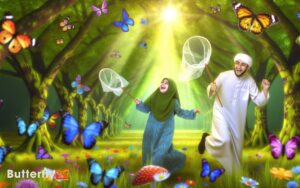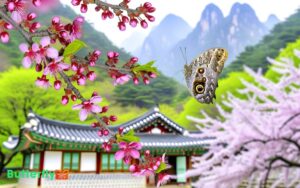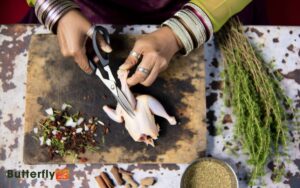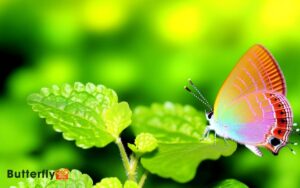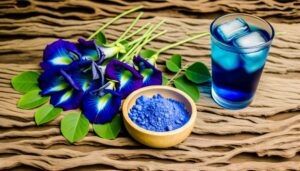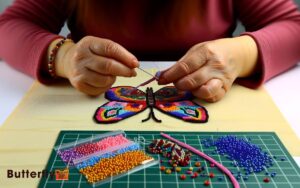7 Perfect Plants to Pair with Your Butterfly Bush
For ideal compatibility with butterfly bush (Buddleja spp.), incorporate species that bolster drought tolerance, biodiversity, and visual appeal. Sedum and yarrow offer exceptional drought resistance and soil stabilization, while lavender, coneflowers, and salvia attract essential pollinators.
Black-eyed Susans and bee balm enhance ecological function and prolong blooming periods. Catmint and ornamental grasses like Miscanthus sinensis add sustainable, low-maintenance elements to your garden.
Selecting these companions guarantees an attractive and resilient garden ecosystem. Understanding their detailed benefits can help maximize your garden's potential.
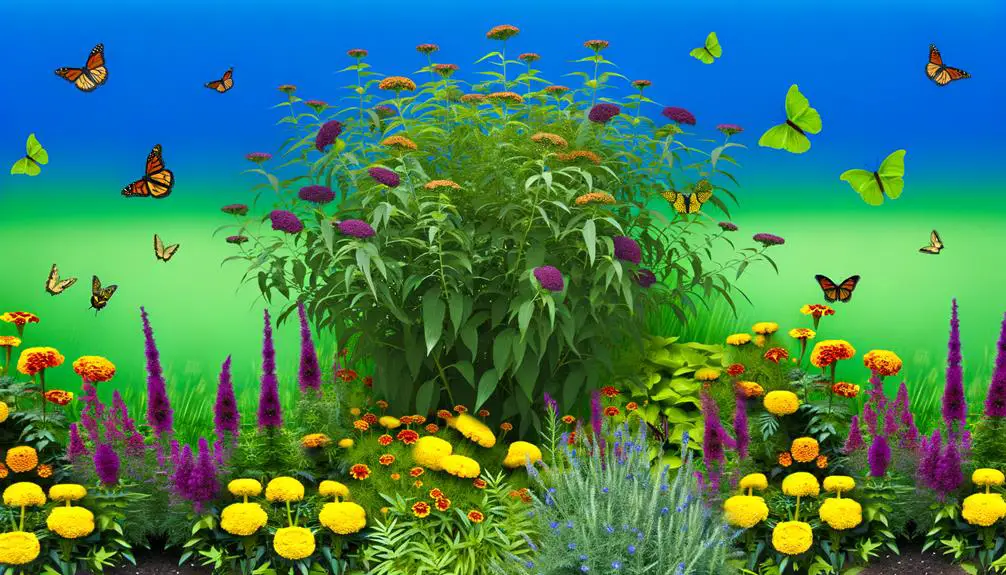
Key Takeaways
- Lavender: Complements butterfly bush with aromatic foliage and attracts pollinators like bees and butterflies.
- Coneflowers: Deep taproots for soil stability and prolonged blooming period to enhance visual appeal.
- Yarrow: Drought-tolerant, adaptable to various soil conditions, and provides habitat for beneficial insects.
- Sedum: Excellent for xeriscaping with high drought tolerance and soil stabilization properties.
Lavender
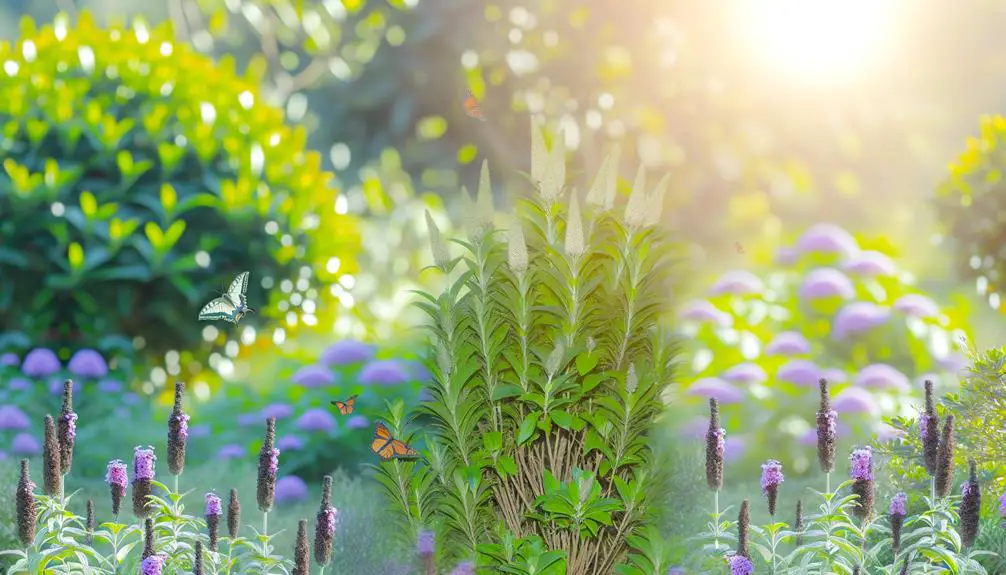
Given its similar soil and sunlight requirements, lavender (Lavandula spp.) serves as an ideal companion plant for butterfly bush (Buddleja spp.), enhancing both aesthetic appeal and ecological benefits.
Both species thrive in well-drained, slightly alkaline soils with full sun exposure. Lavender's aromatic foliage and vibrant purple flowers provide a striking contrast to the butterfly bush's elongated, nectar-rich blooms, creating a visually appealing landscape.
Furthermore, lavender's essential oils act as natural pest deterrents, reducing the likelihood of infestations that could affect butterfly bush health.
Research indicates that the presence of lavender also attracts pollinators like bees and butterflies, fostering a biodiverse ecosystem.
This symbiotic relationship underscores the horticultural synergy between these two resilient, drought-tolerant plants.
Coneflowers
Complementing the lavender, coneflowers (Echinacea spp.) offer additional ecological and aesthetic benefits when planted alongside butterfly bush, thriving in similar growing conditions and attracting a diverse array of pollinators.
These herbaceous perennials, characterized by their sturdy stems and vibrant, daisy-like flowers, excel in well-drained soil with full sun exposure, mirroring the environmental preferences of Buddleia. Coneflowers are particularly effective at drawing bees, butterflies, and other beneficial insects, thereby enhancing pollination dynamics within the garden ecosystem.
Research indicates that Echinacea's deep taproots contribute to soil stability and water retention, which can be advantageous in mixed plantings.
Furthermore, their prolonged blooming period from mid-summer to fall guarantees continuous visual interest and sustenance for pollinators, harmonizing beautifully with butterfly bush’s floral display. This extended flowering time not only enhances garden aesthetics but also supports a diverse range of beneficial insects. Among the 10 plants butterflies pollinate, these blooms stand out as a critical nectar source, ensuring a vibrant and dynamic ecosystem. Their presence fosters a thriving habitat, attracting butterflies, bees, and other pollinators throughout the seasons.
Salvia
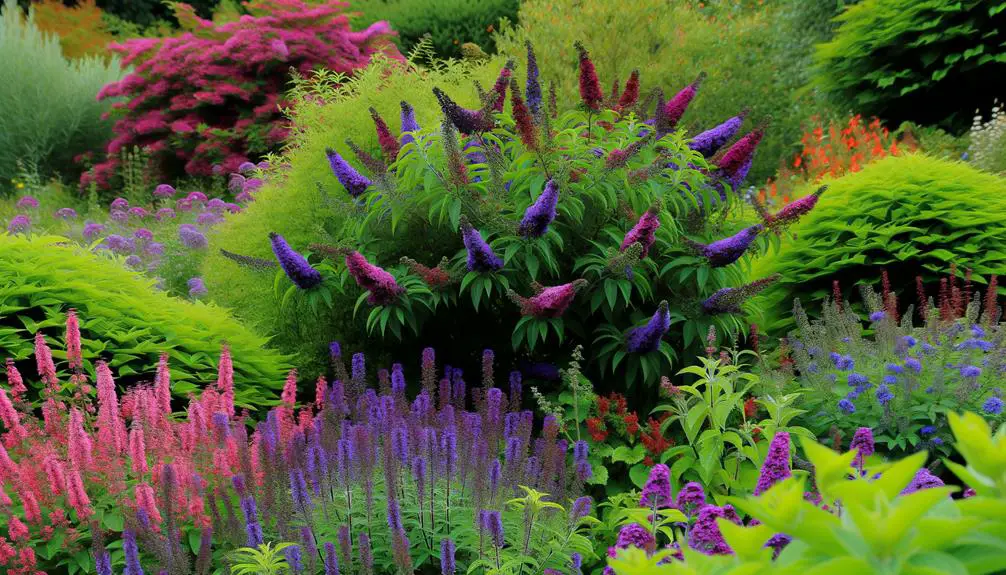
Salvia, known for its vibrant spikes of tubular flowers and aromatic foliage, serves as an excellent companion to butterfly bush, contributing to both biodiversity and visual appeal in the garden. This perennial, thriving in USDA hardiness zones 4-10, provides a continuous nectar source that attracts pollinators such as bees, butterflies, and hummingbirds.
The robust root systems of Salvia enhance soil structure and prevent erosion, while its drought tolerance complements the butterfly bush's low water requirements.
- Pollinator Attraction: Salvia's nectar-rich flowers attract a variety of beneficial insects.
- Soil Health: Deep roots improve soil aeration and structure.
- Drought Tolerance: Both plants thrive in similar water conditions.
Yarrow
Yarrow, with its finely dissected, feathery foliage and clusters of tiny, long-lasting flowers, serves as an exceptional companion to butterfly bush, particularly in its ability to enhance garden biodiversity and provide critical habitat for beneficial insects. Yarrow's drought tolerance and adaptability to various soil conditions make it an ideal plant for diverse garden ecosystems. Additionally, its flowers attract a plethora of pollinators, including bees and butterflies, which can help increase the pollination efficiency of the butterfly bush.
| Characteristic | Yarrow | Butterfly Bush |
|---|---|---|
| Foliage | Finely dissected, feathery | Elongated, lanceolate |
| Flower Type | Clusters of tiny flowers | Large panicles of flowers |
| Drought Tolerance | High | Moderate to high |
| Soil Requirement | Well-drained | Well-drained, fertile |
Incorporating yarrow with butterfly bush creates a synergistic, resilient garden habitat.
Black-eyed Susans
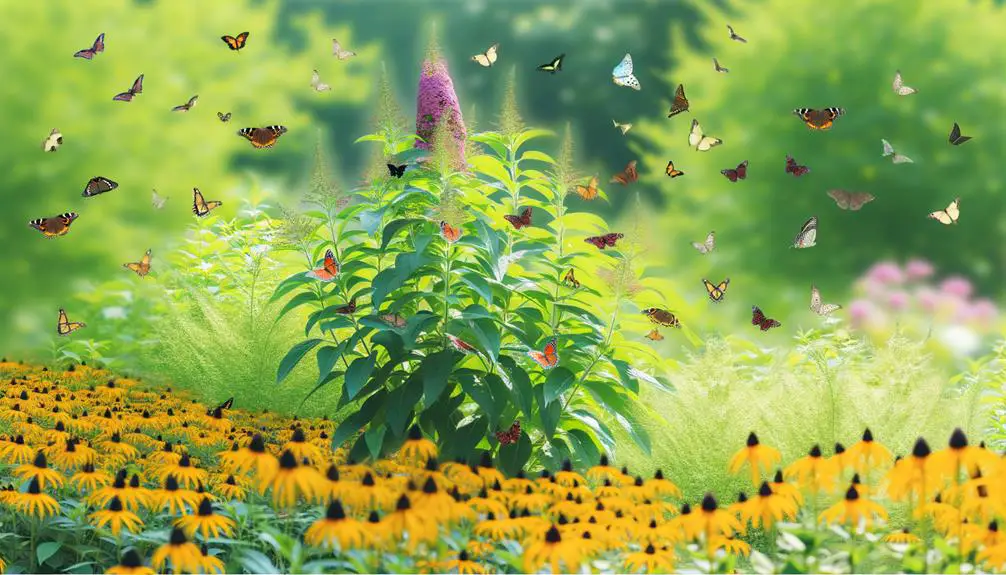
Black-eyed Susans (Rudbeckia hirta) offer a striking visual contrast when paired with butterfly bushes (Buddleja spp.) due to their vibrant yellow petals juxtaposed against the butterfly bush's purple or white inflorescences.
This complementary color pairing not only enhances garden aesthetics but also optimizes pollinator attraction, as both plant species are known to be highly effective in luring bees and butterflies.
Research indicates that the overlapping bloom periods of these plants can extend the duration of pollinator activity, thereby fostering a more dynamic and beneficial ecosystem.
Complementary Color Pairing
Incorporating Rudbeckia hirta, commonly known as Black-eyed Susans, alongside butterfly bushes can create a visually striking garden arrangement through their complementary color pairing. The vibrant yellow petals with dark central cones of Black-eyed Susans juxtapose beautifully with the rich purple, pink, or white blossoms of butterfly bushes. This color contrast not only enhances aesthetic appeal but also adheres to principles of color theory, providing a harmonious yet dynamic visual effect.
Seasonal Interest: Both plants bloom simultaneously, offering continuous visual appeal.
Textural Contrast: The daisy-like form of Black-eyed Susans contrasts with the elongated panicles of butterfly bushes.
Height Variation: Black-eyed Susans' moderate height complements the taller butterfly bushes, adding depth.
Low Maintenance: Both species are drought-tolerant and require minimal care.
Pollinator Attraction Benefits
In addition to their aesthetic contributions, Rudbeckia hirta greatly enhance the ecological value of a garden by attracting a diverse array of pollinators, including bees, butterflies, and other beneficial insects.
The composite flowers of Black-eyed Susans provide both nectar and pollen, serving as essential resources for these organisms.
Studies indicate that the high visibility of their bright yellow petals and the accessibility of their floral structure considerably increase pollinator visitation rates.
By incorporating Black-eyed Susans alongside Butterfly Bush (Buddleja davidii), gardeners can create a synergistic environment that supports pollinator biodiversity.
This combination not only bolsters the reproductive success of both plant species but also contributes to broader ecosystem health by facilitating effective pollination services.
Catmint
Catmint (Nepeta spp.) offers a complementary pairing with butterfly bush due to its drought tolerance, aromatic foliage, and extended blooming period, which collectively enhance garden biodiversity and aesthetic appeal.
The robust adaptability of Catmint to various soil types and its low maintenance requirements make it an ideal companion plant. Its blue to lavender flowers attract pollinators such as bees and butterflies, ensuring a thriving ecosystem. Additionally, Catmint's sprawling growth habit provides an effective ground cover, reducing weed competition and soil erosion.
- Drought Tolerance: Thrives in arid conditions, reducing the need for frequent irrigation.
- Aromatic Foliage: Emits a pleasant scent, deterring pests while attracting beneficial insects.
- Extended Blooming Period: Flowers from late spring to early fall, complementing the butterfly bush.
Sedum
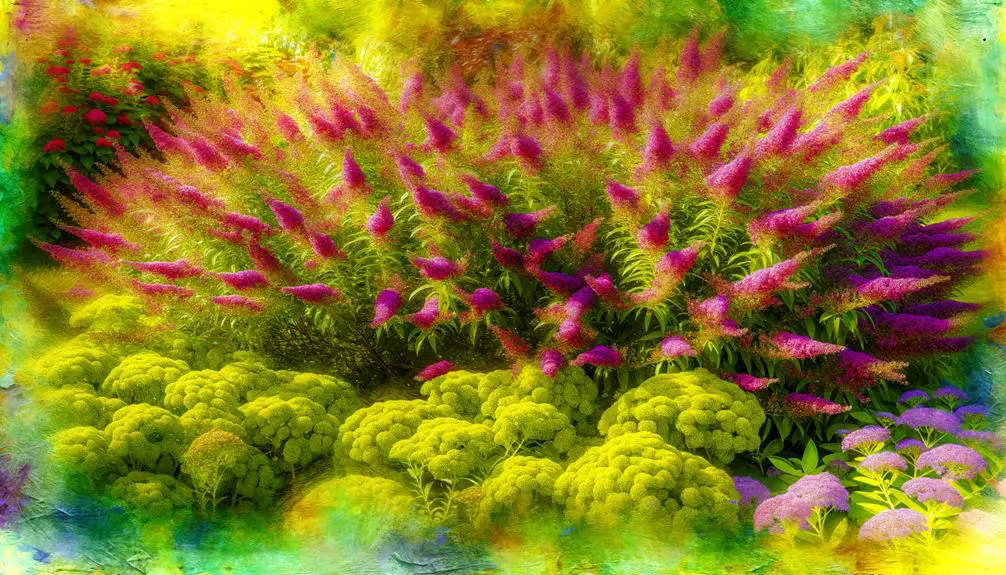
Sedum, when paired with Butterfly Bush, creates a visually appealing garden due to their complementary color schemes, enhancing the aesthetic diversity of the landscape.
Additionally, both plants exhibit high drought tolerance, making them suitable companions in xeriscaping practices.
This combination not only reduces water consumption but also guarantees sustained floral interest throughout the growing season.
Complementary Color Schemes
Utilizing complementary color schemes, such as pairing the vibrant hues of butterfly bush with the contrasting tones of sedum, can enhance the visual appeal and ecological functionality of a garden.
Sedum, with its fleshy leaves and varied palette ranging from deep purples to bright greens, offers a striking counterpoint to the butterfly bush's profusion of blooms. This combination does not only create a visually stimulating garden but also promotes biodiversity by attracting a diverse array of pollinators.
- Visual Contrast: Sedum's muted tones balance the butterfly bush's vivid colors.
- Seasonal Interest: Sedum's foliage and late blooms extend garden interest beyond the butterfly bush's primary flowering period.
- Textural Diversity: The juxtaposition of sedum's succulent leaves with the butterfly bush's airy flowers adds textural complexity.
Drought Tolerance Benefits
Building upon the ecological synergy and visual appeal provided by sedum and butterfly bush, an additional benefit of incorporating sedum into the garden is its remarkable drought tolerance, making it an ideal choice for water-efficient landscaping.
Sedum, a succulent genus known for its crassulacean acid metabolism (CAM) photosynthesis, efficiently conserves water by opening stomata at night to minimize evapotranspiration. This physiological adaptation enables sedum to thrive in arid conditions, reducing the need for supplemental irrigation.
Moreover, the extensive root system of sedum aids in soil stabilization, enhancing its suitability for xeriscaping.
Integrating sedum with butterfly bush not only conserves water but also creates a resilient garden ecosystem capable of withstanding prolonged dry spells, ensuring sustainable and low-maintenance horticulture.
Bee Balm
Incorporating Bee Balm (Monarda spp.) with Butterfly Bush (Buddleia spp.) enhances pollinator attraction and biodiversity in garden ecosystems due to its vibrant blooms and nectar-rich flowers.
Bee Balm, known for its tubular flowers, provides essential nectar sources for hummingbirds, bees, and butterflies, complementing the Butterfly Bush's floral display. This combination supports prolonged flowering periods and diverse pollinator habitats.
- Extended Bloom Time: Bee Balm blooms from mid-summer to early fall, bridging blooming gaps in garden design.
- Disease Resistance: Modern cultivars offer improved resistance to powdery mildew, ensuring healthier garden specimens.
- Soil Preference: Thrives in well-drained, moderately fertile soils, similar to Butterfly Bush, facilitating cohesive planting.
Ornamental Grasses
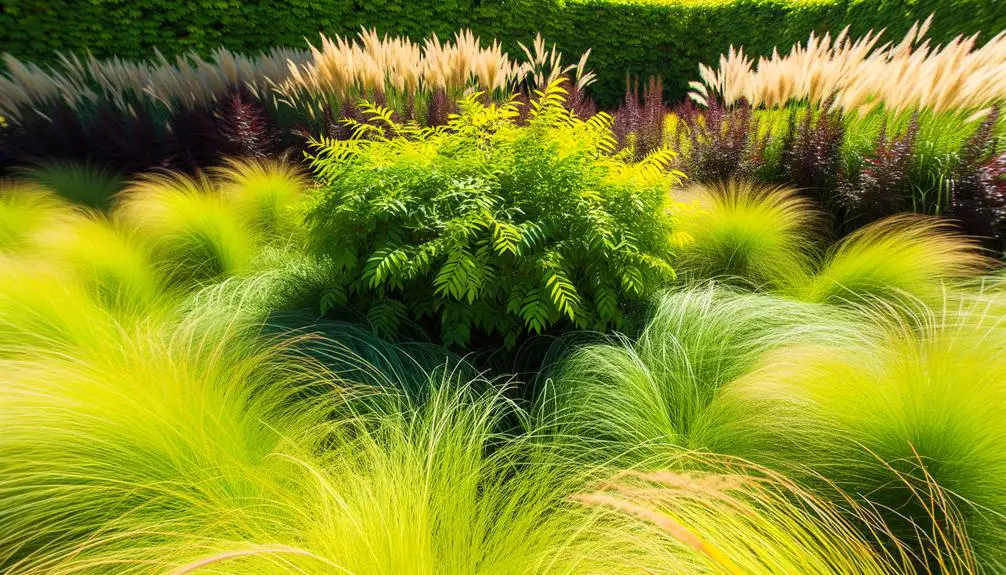
Ornamental grasses, such as Miscanthus and Panicum species, contribute texture, movement, and architectural interest to garden designs when paired with Butterfly Bush (Buddleia spp.).
These grasses offer a dynamic contrast to the bold, vibrant blooms of Buddleia through their fine, feathery foliage and vertical growth habit.
Miscanthus sinensis, known for its tall stature and plume-like flowers, complements the shrub's structure, creating a layered visual effect.
Panicum virgatum, or switchgrass, exhibits a more upright form with airy seed heads that catch light, enhancing the garden's aesthetic appeal.
Both genera thrive in well-drained soils and full sun, mirroring the cultural requirements of Butterfly Bush, thereby ensuring a harmonious and sustainable planting scheme.
Conclusion
In the harmonious garden symphony, each plant plays a crucial role, creating a balanced ecosystem.
The butterfly bush stands as the centerpiece, surrounded by the melodic hues of lavender, coneflowers, salvia, yarrow, and black-eyed Susans.
Catmint, sedum, bee balm, and ornamental grasses contribute their unique textures and colors, enhancing the ecological tapestry.
This botanical arrangement not only enhances aesthetic appeal but also fosters a thriving pollinator habitat, symbolizing the seamless integration of beauty and functionality in horticultural design.

